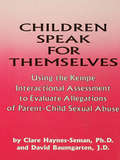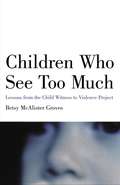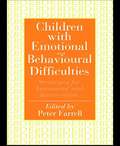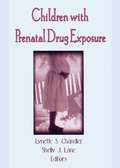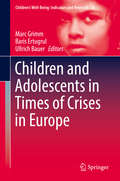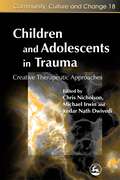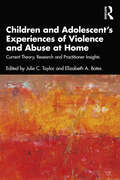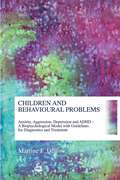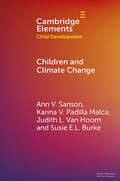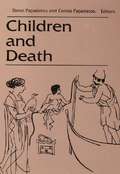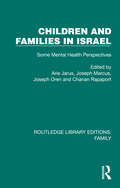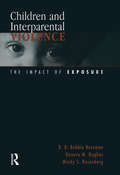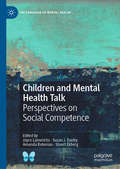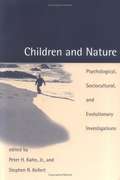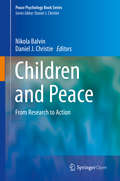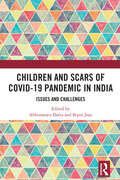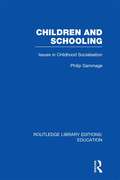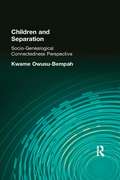- Table View
- List View
Children Speak For Themselves: Using The Kempe Interactional Assessment To Evaluate Allegations Of Parent- child sexual abuse
by Clare Haynes-Seman David BaumgartenFirst published in 1995. Routledge is an imprint of Taylor & Francis, an informa company.
Children Who Fail at School But Succeed at Life: Lessons from Lives Well-Lived
by Mark KatzUnderstanding resiliency and student success by studying people who succumbed to risk but later triumphed. A number of people who failed in school currently enjoy meaningful and successful lives. They include, though they are by no means limited to, those with attention and executive function challenges, learning disabilities, learning and behavioral challenges arising out of traumatic events in their lives, and even those impacted by all of the above. Up until recently, little attention was paid to successful people who did poorly in school. Why? One reason might be that many of us doubted that it was actually possible. After all, many loving parents and caring teachers spent countless hours trying their hardest to help these failing children turn things around in school, sometimes with little or nothing to show for it. If these children continued to struggle and fail in school with all this help and support, it was understandable to assume that they would not succeed in the real world decades later without it. So what did we miss? Why were we so wrong about them? And perhaps most importantly, how can their life experiences help educators and parents understand what schools can do better to support students who are struggling today? In his groundbreaking new book, Mark Katz draws on research findings in clinical and social psychology, cognitive neuroscience, education, and other fields of study--as well as stories of successful individuals who overcame years of school failure--to answer these and other questions. In the process, he shows how children who fail at school but succeed at life can give teachers and schools, counselors and health care professionals, parents and guardians--even those whose childhood struggles have persisted into their adult years--new remedies for combatting learning, behavioral, and emotional challenges; reducing juvenile crime, school dropout, and substance abuse; improving our health and well-being; and preventing medical problems later in life.
Children Who See Too Much: Lessons From The Child Witness To Violence Project
by Betsy Mcalister GrovesFor the last ten years Betsy Groves has been working with children traumatized by witnessing violence. In this book she shows how children understand, respond to, and are affected by violence, especially domestic violence. Groves makes the powerful case that traumatic events carried out by family members carry the most severe psychological risks for very young children. She uses clinical case studies to show that being young does not protect against the lasting effects of witnessing violence, and she offers ways adults can help.
Children With Autism: A Developmental Perspective (The Developing Child Ser.)
by Lisa Capps Marian SigmanChildren with Autism is unique in that it views autism through the lens of developmental psychopathology, a discipline grounded in the belief that studies of normal and abnormal development can inform and enhance one another. <P><P>Sigman and Capps conduct readers through the course of development from infancy to adulthood, outlining the differences between normal and autistic individuals at each stage and highlighting the links between growth in cognitive, social, and emotional domains. <P><P>In particular, Sigman and Capps suggest that deficits in social understanding emerge in the early infancy of autistic children, and they explore how these deficits organize the development of autistic individuals through the course of their lives. They also examine the effects certain characteristics can have on an autistic person's adjustment over time. Their book concludes with an overview of existing interventions and promising avenues for further research.
Children With Cancer: The Quality of Life
by Christine EiserCancer is a very rare disease in children. There have been impressive gains in survival in recent years, and these have been achieved through the use of chemotherapy and national and international clinical trials. The diagnosis of cancer in a child imposes considerable stress on the whole family. In the immediate time after diagnosis, parents must learn about the disease and its treatment, explain what is happening to the child, and make arrangements for the care of other children in the family. For the child, treatment is associated with many side effects depending on the specific drugs used. In addition, the child is prone to infection and therefore is likely to miss a lot of school and other activities. For all these reasons, physicians and families have become aware that cancer has huge implications for the quality of the child's life. This book is an attempt to describe how quality of life is affected at different stages of the disease process. Comprehensive reviews are provided of the impact on the child's physical activity, social life, and school and educational achievements. Special consideration is given to children with leukemia (one of the more common cancers) and brain tumors. Cancer does not just affect the child but every member of the family. Consequently there is coverage of the effects on parents and also healthy brothers and sisters. To the extent that improvements in survival have been achieved by national and international collaboration between clinicians, it is concluded that efforts to improve the quality of these children's lives is dependent on collaboration between clinicians, nurses, and behavioral scientists at national and international levels. This book should provide an impetus for such collaboration.
Children With Emotional And Behavioural Difficulties: Strategies For Assessment And Intervention
by Peter FarrellBlending academic theory with policy guidelines and practical suggestions, this book provides a review of current approaches to assessment and Intervention For Children With Emotional And Behavioural Difficulties. It incorporates a discussion of government guidelines on policy and provision with schools and LEAs and reviews a range of successful innovations in intervention. Specific areas are covered, including Exclusion, Integration And Emotional Abuse.; Five Recurring Themes permeate the whole book, these being: the effects of government legislation on all aspects of EBD assessment and provision; the recognition that children with EBD come from economically and socially disadvantaged families and the implication that this has for assessment and provision; the problems of agreeing on an acceptable definition of EBD; the fact that children labelled as EBD do not have an equal opportunity to assessment and provision; and the belief that schools can make a substantial contribution to the prevention of EBD.
Children With Prenatal Drug Exposure
by Lynette S Chandler Shelly J LaneChildren With Prenatal Drug Exposure examines new medical approaches for predicting the developmental progress of children who have been exposed to drugs in utero. This book outlines effective methods for intervention and assessment and indicates future directions for investigation. It provides practical and up-to-date information on treatments and research development, while it encourages practitioners to come to their own conclusions through careful documentation and analysis of each case.Children With Prenatal Drug Exposure cuts across many disciplines to provide the reader with a vivid analysis of the complexities and challenges surrounding health care of children who have been prenatally exposed to drugs. This guidebook explores the controversies over treatment and therapy options and the ethics of care. It advocates positive outcome intervention methods that promote the health interests of both mother and unborn child whenever possible, with an emphasis on clinical efforts geared to change maternal behavior.Practical and comprehensive, Children With Prenatal Drug Exposure explores a full range of provoking topics, including: neurological effects and sensory motor delays caused by cocaine exposure foster care and its impact on motor development adolescent pregnancy and the complications of prenatal substance abuse ethical dilemmas multidimensional measurement systems and longitudinal researchThe book’s authors believe that in order to meet the needs of children who have been prenatally exposed to drugs, care providers must know the limitations associated with the process and methodology of assessment and learn to address the shortcomings of evaluation. With this in mind, this book aims to equip psychologists, physical and occupational therapists, researchers, and physicians with the “know-how” they require for optimizing their health care services and contributing valuable research that the field so urgently needs.
Children and Adolescents in Times of Crises in Europe (Children’s Well-Being: Indicators and Research #20)
by Ullrich Bauer Marc Grimm Baris ErtugrulThis book presents an analysis of the impact of the social crisis on the well-being of children and adolescents in Europe. Focusing on the fields of health, employment and social status, this book highlights that the impact of crisis has to be viewed in light of the state policies in reaction to crisis. Chapters in the book offer new perspectives of a reflexive crisis research objectifying crisis and analyzing what is referred to as crisis by whom, how, for what purposes and with which implicit or explicit solutions. This book offers empirical evidence and unique analytical approaches in the field of a child- and adolescent-oriented crisis research.
Children and Adolescents: A Biocultural Approach to Psychological Development
by Theron AlexanderAn individual's understanding of himself must begin with an appreciation of his origin. Thus, the concern of modern man to understand his behavior has led to an investigation of the forces that influence human development. Investigation encompasses many academic subjects: genetics, biology, medicine, physiology, anatomy, biochemistry, sociology, anthropology, history, and psychology. However, each of these subjects falls into one or both of two broad categories-the biological and the cultural. In short, all human behavior is determined by both the biological characteristics and the environmental characteristics of the culture.Underlying the solution to any of today's social problems is, of course, the need for a clearer understanding of human psychological development. Children and Adolescents is a unique book in its approach to developmental psychology. Successfully integrating both the biological and the cultural influences, which determine the behavior of a child, the book begins with a discussion of behavioral development in infancy and a description of the physiological foundation of such early behavior.Alexander traces the process of growth through middle childhood and adolescence. Concerned with the normal difficulties and problems that arise in childhood, he demonstrates --by means of actual case studies the importance of early motivation and cognitive processes, particularly the need for self-direction in all developing children, the process of individual change through varying kinds of experiences, and the relationship of the child to authority.Children and Adolescents provides vital and well-organized material for all courses in child behavior--whether taught in departments of psychology, education, or home economics. Professionals concerned with social problems and child development will discover a stimulating new approach to the process of psychological growth.
Children and Adolescent’s Experiences of Violence and Abuse at Home: Current Theory, Research and Practitioner Insights
by Elizabeth A. Bates Julie C. TaylorChildren and Adolescent’s Experiences of Violence and Abuse at Home is a unique book that explores some of the main controversies and challenges within the field. The book is organised into three sections, the first covering work that has focused on the experiences of living in DV settings as a child or young person, the second offers overviews of the impact of child victimisation and the final section is about working with children in practice and service-based settings. It includes extensive reviews of the literature, empirical research and practice observations, all of which provide compelling evidence of a need to change how we construct victims and design services. It provides evidence for the need to work sensitively, inclusively, and responsively around issues of victim identification, support, and prevention. Moreover, the evidence urges us to include children’s and adult victim/survivor’s experiences and contributions in the creation of services. Concluding with a series of recommendations for both future research, and ways in which we can help use the research findings to inform practice, it is a must-read for researchers, practitioners and educators working with children and young people within the field of domestic violence and abuse. It will also be of interest and value to policy makers who are reviewing legislation and those involved in commissioning psychological services, and victim services that work with child and adolescent victims.
Children and Behavioural Problems: Anxiety, Aggression, Depression and ADHD – A Biopsychological Model with Guidelines for Diagnostics and Treatment
by Martine DelfosIn this wide-reaching and comprehensive book psychologist Martine F. Delfos provides practical guidance on the diagnosis, support and treatment of a variety of childhood behavioural problems, including anxiety problems, aggression, depression and ADHD. Presenting a useful and compelling model of the interplay of environment, disposition and central nervous system development, Delfos shows how differences in brain structure between the sexes may have a part to play in behavioural problems in children and adolescents. Children and Behavioural Problems is an essential resource for teachers, psychologists, social workers and other professionals working with children, as well as for parents seeking to support their children with special needs throughout their development.
Children and Climate Change (Elements in Child Development)
by Judith Van Hoorn Ann V. Sanson Karina Padilla Malca Susie BurkeThe existential threat posed by climate change presents a challenge to all those concerned about the next generation. This Element reviews and discusses its implications for the development of children (ages 0-12) today and in the future, and for the parents, teachers, researchers, and professionals who have responsibility for children. This Element adopts a bioecological model to examine both the direct impacts on children's physical and psychological well-being as well as indirect impacts through all the systems external to the child, emphasizing the greater vulnerability of children in the Global South. Given evidence of well-founded climate anxiety, this Element examines children's coping strategies and discusses the key roles of caregivers and schools in protecting and preparing children to face current and future challenges – with knowledge, hope, and agency as central themes. This Element highlights many under-researched areas and calls for action by all those caring for and about children's future.
Children and Death (Death Education, Aging and Health Care)
by Danai Papadatou Costas PapadatosFirst published in 1991. Routledge is an imprint of Taylor & Francis, an informa company.
Children and Disasters (Series in Trauma and Loss)
by Carl A. Maida Norman L. Farberow Norma GordonWhen disaster strikes, survivors suddenly find themselves in a world that has become confusing and unfamiliar. Such traumatic events impose severe psychological strain on every member of a community, but children are a particularly vulnerable group requiring special attention. Children and Disasters addresses the needs of this specific population by examining the impact of major disasters on the mental health and emotional functioning of children.The programs described in this book are designed to provide early intervention to children and families undergoing stress reactions to a catastrophic event. The authors offer interventions aimed at enhancing the skills of mental health professionals, educators, and peer counselors in responding to the intensified demands of disasters. These intervention approaches provide information regarding the event itself, reinforce the legitimacy of the anxieties and fears that children and their families are experiencing, and encourage the expression of feelings in group and individual settings (for the younger child, through drawing and play). Furthermore, they build on the coping capacity of individuals and theirs families and provide concrete coping skills and techniques to alleviate stress reactions.The intervention model can be applied to programs for individual children and their families, multi-family groups, and groups for children in mental health, educational, and community settings. The practical "hands-on" approach to program design makes this book an attractive resource for mental health professionals, social workers, rehabilitation specialists, professional and volunteer counselors, and suicide intervention workers. It will also be useful for school personnel, including teachers, school counselors, and administrators, as well as federal and state emergency planners and coordinators.
Children and Families in Israel: Some Mental Health Perspectives (Routledge Library Editions: Family)
by Arie Jarus Joseph Marcus Joseph Oren Chanan RapaportOriginally published in 1970, this title was intended to describe a wide and complex network of historical, social, psychological and medical issues. It starts with an overview of Israel as a society and how it is similar yet differs from that the reader may be familiar with. Divided into three parts, the first looks at the basic fabric and main patterns of social and psychological issues in Israel and provides the background for specific mental health problems. The second part deals with selected groups of population, or problem areas which are of special interest from the viewpoint of mental health issues, and that receive special attention by the society itself. This includes the child outside his family, the immigrant child absorbed by the program of Youth Aliyah, socially deprived or vulnerable children, those with disabilities, and delinquency. The final part deals with ways and means of providing service and care for those who eventually need attention. This includes descriptions of the mental health professions, the available psychiatric services, the role of voluntary agencies in providing care, and finally a discussion of issues in planning and research. Today it can be read in its historical context.
Children and Interparental Violence: The Impact of Exposure
by B. B. Rossman Honore M. Hughes Mindy S. RosenbergThe past decade has seen a burgeoning of research and conceptualization on the implications of parental violence exposure on children's development and well-being. Meanwhile, seemingly daily accounts of violent tragedies committed by our youth brings to our attention the urgency of conveying this information. With these ideas in mind, Children and Interparental Violence focuses on childrens exposure to violence between their caretakers and the subsequent effects on child development.To this end, the authors review current theories, research, and treatment strategies of the 1990s, paying specific attention to families' ethnic backgrounds, parents' sexual orientation, and forensic and legal issues, all factors affecting the nature and severity of impact.Prevention and intervention models (including great detail on risk and protective factors), techniques, and programs are discussed, as well as research evaluating their usefulness. Keeping in mind the goal of integrating practice and policy with current violence and developmental research and theory, numerous case examples take the reader from the lab and classroom into the session room and courtroom.
Children and Materialities: The Force of the More-than-human in Children’s Classroom Lives (Children: Global Posthumanist Perspectives and Materialist Theories)
by Casey Y. MyersThis book makes the case for young children as both keenly materially aware of and highly dependent on sets of interrelated material-discursive circumstances. It argues that long-term engagement with children around the topic of meaning-matter relations upends many taken-for-granted notions of consumption, self-regulation, knowledge production, and what constitutes quality of life within a school setting.The book provides complex accounts of agency on multiple scales - the capability of children to shape and share research, the force of objects, stuff, and things to impact the "social" workings of a classroom, and the impact of nonhuman animals on the trajectory of the ways in which children relate to each other.This work makes a significant contribution to both theoretical conceptions and practical enactments of childhoods, productively addressing the many contradictions inherent in a posthuman and participatory approach to researching with young children. It also offers insights into how the everyday materialities of children’s classrooms (and their complex representations) are capable of disrupting the common-sense order of things.
Children and Mental Health Talk: Perspectives on Social Competence (The Language of Mental Health)
by Amanda Bateman Susan J. Danby Joyce Lamerichs Stuart EkbergThis timely collection explores how children display social competence in talking about their mental health and wellbeing. The authors analyse recorded conversations of young people’s interactions with professionals in which they disclose particular mental health concerns and their ways of coping, drawing on insights from ethnomethodology, conversation analysis and discursive psychology. Across a diverse range of institutional and international settings, chapters examine how children and young people employ interactional strategies to demonstrate their competence. The research reveals how young people resist or protect claims that they lack competence, especially in contexts where they might be seen as seeking or asking for support, or when their (dis)abilities and mental health is explicitly up for discussion.Each chapter concludes with a reflection on the methodological, professional and practical implications of the findings, highlighting areas where future research is necessary and addressing the empirical findings from the authors professional vision, facilitating innovative dialogue between conversation analytic research and professional vision. This book will be of great value to academics and professionals interested in how children express themselves, particularly in relation to their mental wellbeing.
Children and Nature: Psychological, Sociocultural, and Evolutionary Investigations
by Peter H. Kahn Stephen R. Kellert<p>For much of human evolution, the natural world was one of the most important contexts of children's maturation. Indeed, the experience of nature was, and still may be, a critical component of human physical, emotional, intellectual, and even moral development. Yet scientific knowledge of the significance of nature during the different stages of childhood is sparse. This book provides scientific investigations and thought-provoking essays on children and nature. <p>Children and Nature incorporates research from cognitive science, developmental psychology, ecology, education, environmental studies, evolutionary psychology, political science, primatology, psychiatry, and social psychology. The authors examine the evolutionary significance of nature during childhood; the formation of children's conceptions, values, and sympathies toward the natural world; how contact with nature affects children's physical and mental development; and the educational and political consequences of the weakened childhood experience of nature in modern society.</p>
Children and Peace: From Research to Action (Peace Psychology Book Series)
by Nikola Balvin Daniel J. ChristieThis open access book brings together discourse on children and peace from the 15th International Symposium on the Contributions of Psychology to Peace, covering issues pertinent to children and peace and approaches to making their world safer, fairer and more sustainable. The book is divided into nine sections that examine traditional themes (social construction and deconstruction of diversity, intergenerational transitions and memories of war, and multiculturalism), as well as contemporary issues such as Europe’s “migration crisis”, radicalization and violent extremism, and violence in families, schools and communities. Chapters contextualize each issue within specific social ecological frameworks in order to reflect on the multiplicity of influences that affect different outcomes and to discuss how the findings can be applied in different contexts. The volume also provides solutions and hope through its focus on youth empowerment and peacebuilding programs for children and families. This forward-thinking volume offers a multitude of views, approaches, and strategies for research and activism drawn from peace psychology scholars and United Nations researchers and practitioners.This book's multi-layered emphasis on context, structural determinants of peace and conflict, and use of research for action towards social cohesion for children and youth has not been brought together in other peace psychology literature to the same extent. Children and Peace: From Research to Action will be a useful resource for peace psychology academics and students, as well as social and developmental psychology academics and students, peace and development practitioners and activists, policy makers who need to make decisions about the matters covered in the book, child rights advocates and members of multilateral organizations such as the UN.
Children and Scars of COVID-19 Pandemic in India: Issues and Challenges
by Abhimanyu Datta Bipin JojoThis volume discusses the various challenges faced by children in India from different perspectives such as education, psychology, and sociology during the COVID-19 pandemic. It highlights the nature of undocumented struggles of refugees, children with special needs, girl children/ girl child, child labourers, children from SC/ST and other disadvantaged communities and migrant children in India. The book examines the lack of a social justice framework to cater to children’s needs and wellbeing. It discusses how intersectional location of these children in caste, class, gender, ethnicity, and religious locations shape their ability to access welfare and rights across sectors such as health, education, nutrition, and security. The book puts forth recommendations to ensure better intervention mechanisms to address issues faced by children from all sections of society and paves the way to counter the emerging challenges in future.This book will be of interest to students, teachers, and researchers of education, psychology, sociology, social work, childhood studies, and development studies. It will also be useful for educationalists, sociologists, social psychologists, lay public and those interested in exploring the condition of various marginalized children in India.
Children and Schooling: Issues In Childhood Socialization (Routledge Library Editions: Education)
by Phillip GammageThe book provides a synthesis of a broadly-based social-psychology of education and bridges the gap between theory and practice in education by emphasising the relationship between research and actuality. The author discusses the major issues in childhood socialisation relating to schooling, achievement and the curriculum, and in so doing makes a sensitive and well-argued case for the social-psychological perspective.He presents a social-psychologist’s view of the interaction between child, school and curriculum, and summarises mainstream psychological contributions to current thinking on achievement, self-esteem and education. He covers areas of social learning and attribution theory not commonly dealt with in education texts, showing that there are major fields of research which have until now been neglected. Children and Schooling is constructed so that its chapters can be used as independent study-guides to specific subjects or read in sequence, each subject inter-related. The text can be treated as an introduction, particularly in view of the notes and comprehensive and apposite scholarly apparatus: and as a spring-board for serious study at advanced level.
Children and Separation: Socio-Genealogical Connectedness Perspective
by Kwame Owusu-BempahChildhood separation and loss have become virtually a way of life for a large number of children throughout the world. Children separated from their genetic parent(s) and consequently their genealogical, social and cultural roots due to processes such as adoption, parental divorce/separation, donor insemination, single parenthood by choice and child trafficking can face social, emotional and psychological difficulties. This book explores the premise that a proper understanding of the complex inner world of modern day separated children and their psycho-social development requires a shift in focus or emphasis. It presents the notion of socio-genealogical connectedness as a new theoretical framework for studying and promoting these children's growth and development. This new theory simultaneously challenges and complements existing notions of psycho-social development, including attachment theory and Erikson's psycho-social theory of personality development. Owusu-Bempah proposes that this sense of socio-genealogical connectedness is an essential factor in children's adjustment to separation and their emotional and mental health; much like those adopted, separated children suffer a loss of genealogical continuity, and hence, loss of 'self'. This hypothesis is discussed and ultimately supported through both the author's own research and a broad selection of theoretical and empirical material from other areas. The book further considers the implications of this notion of socio-genealogical connectedness for childcare policy and practice, as well as directions for future research in this and related fields. Children and Separation is an invaluable resource for academics, students and childcare professionals. The accessible style of the book ensures that it will also be useful to parents and anybody affected by childhood separation.
Children and Sexual-Based Online Harms: A Guide for Professionals
by Catherine KnibbsThis sensitive guide for carers and professionals working with children and young people explains the serious issues of sexual content and harm that children face online. Covering technologies used by children aged two through to adulthood, it offers clear, evidence-based information about sexual-based online harm, its effects and what adults can do to support children should they see, hear or bear witness to these events online. Catherine Knibbs, specialist advisor in the field, explains the issues involved when using online platforms and devices in family, social and educational settings. The guide offers an accessible explanation of how online harm impacts developmental, neurological and social development, as well as young people’s mental health and well-being. Examined in as non-traumatising a way as possible, the book covers key topics, including consent, pornography, online grooming, sexting, live streaming, revenge porn, ASD sexuality and gender, and vigilantism. Offering guidance and proactive and reactive strategies based on neuroscience and child development, it shows how e-safety is not one-size-fits-all and must consider the vulnerabilities of individual children and families. Children and Sexual-Based Online Harms will equip professionals and carers with the knowledge to support their work and to direct conversations about the online harms that children and young people face. It is essential reading for those training and working with children in psychological, educational and social work contexts, as well as parents, policy makers and those involved in the development of online technologies.
